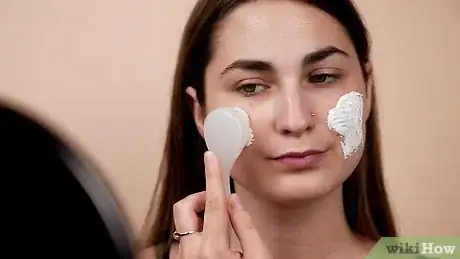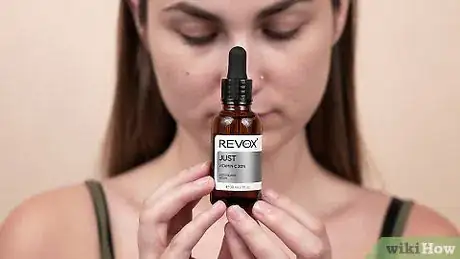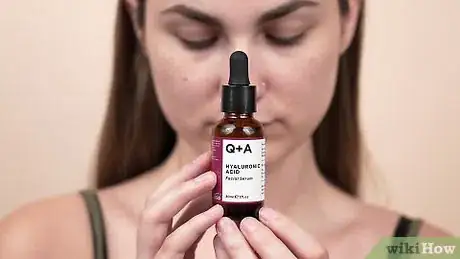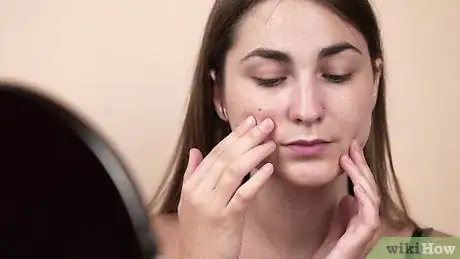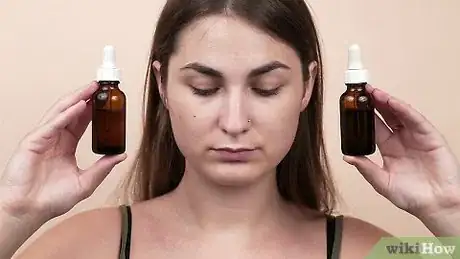This article was co-authored by Kaveri Karhade, MD. Dr. Kaveri Karhade is a board certified Laser, Medical, and Cosmetic Dermatologist in the San Francisco Bay Area. Her areas of expertise are acne and hair loss. She has advanced training in injectables, lasers, surgery, and other cosmetic treatments, and has published extensive research in medical journals. She holds a BS from Michigan State University and a Doctor of Medicine (MD) from the University of Michigan Medical School. She completed her internship in Internal Medicine at New York University School of Medicine and her Residency in Dermatology at Brown University School of Medicine. Dr. Karhade is a fellow of the American Academy of Dermatology and a member of the American Society for Dermatologic Surgery.
There are 12 references cited in this article, which can be found at the bottom of the page.
wikiHow marks an article as reader-approved once it receives enough positive feedback. In this case, 93% of readers who voted found the article helpful, earning it our reader-approved status.
This article has been viewed 510,223 times.
Serums deliver a highly concentrated blast of nutrients directly to your skin. To use, apply a few drops after you wash your face but before you apply moisturizer. Serums absorb deep into your skin, rather than sitting on the surface like moisturizers. Serums work great for specific concerns like acne, dry skin, brightness, and wrinkles. After you wash your face, apply a pea-sized amount of serum to your cheeks, forehead, nose, and chin. For best results, use both a daytime and nighttime serum.
Steps
Applying the Serum
-
1Wash and exfoliate your skin before you apply your serum. Before you apply your serum, wash your face with a facial wash or scrub. Wet your face, then massage your face wash over your forehead, cheeks, nose, and chin. Move your fingers in small, circular motions, then rinse the face wash away. Washing your face removes superficial dirt and oil, while exfoliating gets into your pores for a deep clean.[1]
- For best results, wash your face daily and exfoliate your skin 3-4 times a week. Do not use a manual exfoliator and a chemical exfoliator like glycolic acid in the same day.
-
2Apply 1 drop to each section of your face if using a thin serum. The amount of serum you use will vary depending on the consistency of the ingredients. When using thinner serums, you only need a tiny amount. Apply 1 drop to your finger, then rub onto your cheek. Repeat this for the other cheek, as well as your forehead and nose/chin area. Gently rub the serum in an upwards motion.[2]Advertisement
-
3Warm 3-5 drops in your hands before applying a thick serum to the face. More dense serums need to be warmed up before you apply them. To do this, drip a few drops into the palm of your hand, then rub your hands together. This evenly distributes the product on both of your hands, as well. Then, use gentle pressing movements to apply the serum over your face. Cover both cheeks, your forehead, your nose, and your chin.[3]
- When applying the serum, you want to push the product into your skin with gentle sweeping motions.
-
4Tap your skin gently for 30-60 seconds until the serum is absorbed. After you’ve rubbed the serum onto your skin, place your fingers on your cheek and press your skin in small, circular motions. Repeat this across the entirety of your face for about a minute.[4]
- This way, the serum will absorb deep into your skin.
-
5Wait one minute to apply moisturizer over all of your face. Your serum will mostly dissolve into your skin after about a minute. Then, squeeze a dime-size amount of moisturizer into your hand, and rub it over your forehead, cheeks, nose, and chin.[5]
- The moisturizer seals in all of the serum’s nourishing properties, so your skin will look radiant and glowing in no time.
- If you are doing this in the morning, you can apply your makeup after you apply the moisturizer. Just give the moisturizer another minute to dry before starting your makeup routine.
Choosing a Serum
-
1Try a serum with glycolic acid and aloe vera for an all-purpose option. If you have a “normal” skin type or simply want a serum to keep your skin flawless, try one with these ingredients. Aloe vera reduces redness and boosts skin hydration. Glycolic acid removes dead skin cells so they don’t clog your pores. Great skin starts with hydration![6]
- This is a great option if you don’t have any “problem areas” but still want to treat your skin to rich nourishment. It's also a good option to help fade sun damage and acne scars.
- Additionally, look for serums with rose hip oil. This also reduces redness and helps hydrate the skin.
-
2Use a serum with vitamin C, retinol, salicylic acid, or Benzoyl peroxide to manage acne. The antioxidants in Vitamin C will help revitalize your skin.[7] Retinol and Benzoyl peroxide are powerful anti-acne ingredients, while salicylic acid helps heal existing acne, as well. This combination works great to reduce inflammation or redness manage oil, and treat or prevent acne.[8]
- In addition, serums with these ingredients help unclog your pores.
- Salicylic acid can cause sunburn, so it is best to use this serum at night.
- Niacinamide is also good for hydrating skin that's prone to acne.[9]
-
3Apply a serum with glycolic and hyaluronic acid if you have dry skin. Both glycolic acid and hyaluronic acid help the skin retain moisture. These ingredients team up to deliver a potent, moisturizing serum that works great for dry skin. The serum will not feel like a heavy moisturizer, and it will deeply hydrate your skin in seconds.[10]
- You can also use vitamin E, rose hip oil, chia seeds, sea buckthorn, and camellia to hydrate your skin without clogging your pores.
-
4Choose a serum with retinol and peptides to reduce wrinkles. Retinol plumps up fine lines and wrinkles, and peptides help build healthy skin. Combine these ingredients, and you have a fabulous, wrinkle-reducing serum. For best results, apply these serums at night so your skin can absorb the serum as you sleep, helpful when treating wrinkles.[11]
- You can also use a serum with antioxidants including vitamin C and green tea extract. These ingredients help protect your skin as well as reduce the appearance of wrinkles.
-
5Try serums with vitamin C and ferulic acid to brighten your complexion. Your skin tone can look uneven or dull due to sun exposure, smoking, genetics, and poor sleep. Vitamin C and ferulic acid are powerful antioxidants that can bring your skin back to life. They neutralize free radicals in your skin, making your skin tone more even and lively.[12]
- In addition, many brightening serums use green tea extract, which is another helpful antioxidant.
- Some brightening serums feature snail mucin, which is popular for its ability to repair scars and heal discoloration or uneven spots.[13]
-
6Treat uneven skin tones with licorice root extract and kojic acid. Licorice root extract helps eliminate the appearance of discoloration and age spots. Kojic acid treats scars, sun damage, and uneven skin tones. Within a few weeks, your skin may look even and radiant if you use a serum rich in these ingredients.[14]
- Also look for serums with Vitamin C, as this is known to brighten skin.
- You can also choose a serum with arbutin when evening out your skin tone. Arbutin is commonly used to stop the appearance of dark spots. It also brightens your overall complexion.
- When choosing a serum with vitamin C, look for options with L-ascorbic acid, which is the most effective part of the vitamin. This is helpful when revitalizing an uneven skin tone.
-
7Use an under-the-eye serum to reduce the appearance of dark circles. There are specially formulated serums specifically made to target dark circles under your eyes. If you want to reduce the appearance of under-the-eye circles, opt for one of these. They usually are rich in ingredients like licorice root extract or arbutin. Apply these directly to your under eye region.[15]
- You can use this as well as daytime and nighttime serums.
- Avoid applying under-the-eye serums to other areas of your face. Sometimes the ingredients are more potent to absorb under your eye, and this can cause irritation or breakouts.
-
8Choose both a daytime serum and nighttime serum for best results. Daytime serums are typically less concentrated, so you don't have to worry about sun exposure. Nighttime serums are very concentrated, and the ingredients take effect while you are sleeping. Use both to keep your skin as healthy and flawless as possible.[16]
- Start slowly with your serums to give your skin time to adjust to new products. Start by applying your nightly serum once every other day, and gradually increase build toward nightly application over the course of a few weeks. Then, add your daily serum.
- Use an antioxidant serum in the morning to keep your skin protected. Apply a nighttime serum with retinol to keep a youthful appearance.
Expert Q&A
-
QuestionHow do I stop my face from being so oily?
 Margareth Pierre-Louis, MDDr. Margareth Pierre-Louis is a board certified Dermatologist and Dermatopathologist, Physician Entrepreneur, and the Founder of Twin Cities Dermatology Center and Equation Skin Care in Minneapolis, Minnesota. Twin Cities Dermatology Center is a comprehensive dermatology clinic treating patients of all ages through clinical dermatology, cosmetic dermatology, and telemedicine. Equation Skin Care was created to provide the best in evidence-based, natural skin care products. Dr. Pierre-Louis earned a BS in Biology and an MBA from Duke University, an MD from the University of North Carolina at Chapel Hill, completed a residency in dermatology at the University of Minnesota, and completed a dermatopathology fellowship at Washington University in St Louis. Dr. Pierre-Louis is board certified in dermatology, cutaneous surgery, and dermatopathology by the American Boards of Dermatology and Pathology.
Margareth Pierre-Louis, MDDr. Margareth Pierre-Louis is a board certified Dermatologist and Dermatopathologist, Physician Entrepreneur, and the Founder of Twin Cities Dermatology Center and Equation Skin Care in Minneapolis, Minnesota. Twin Cities Dermatology Center is a comprehensive dermatology clinic treating patients of all ages through clinical dermatology, cosmetic dermatology, and telemedicine. Equation Skin Care was created to provide the best in evidence-based, natural skin care products. Dr. Pierre-Louis earned a BS in Biology and an MBA from Duke University, an MD from the University of North Carolina at Chapel Hill, completed a residency in dermatology at the University of Minnesota, and completed a dermatopathology fellowship at Washington University in St Louis. Dr. Pierre-Louis is board certified in dermatology, cutaneous surgery, and dermatopathology by the American Boards of Dermatology and Pathology.
Board Certified Dermatologist
-
QuestionDo you use a serum before or after moisturizer?
 Laura MartinLaura Martin is a Licensed Cosmetologist in Georgia. She has been a hair stylist since 2007 and a cosmetology teacher since 2013.
Laura MartinLaura Martin is a Licensed Cosmetologist in Georgia. She has been a hair stylist since 2007 and a cosmetology teacher since 2013.
Licensed Cosmetologist Some serums may provide sufficient hydration on their own. If you need to use a moisturizer, apply it after the serum. This will allow the serum to penetrate more deeply into the skin.
Some serums may provide sufficient hydration on their own. If you need to use a moisturizer, apply it after the serum. This will allow the serum to penetrate more deeply into the skin. -
QuestionWhat does a serum do for your face?
 Laura MartinLaura Martin is a Licensed Cosmetologist in Georgia. She has been a hair stylist since 2007 and a cosmetology teacher since 2013.
Laura MartinLaura Martin is a Licensed Cosmetologist in Georgia. She has been a hair stylist since 2007 and a cosmetology teacher since 2013.
Licensed Cosmetologist Serums are made to address a number of skin concerns ranging from dark spots to dryness to wrinkles.
Serums are made to address a number of skin concerns ranging from dark spots to dryness to wrinkles.
Warnings
- Avoid using nighttime serums during the day. This can result in dry skin, breakouts, and sunburn, for instance.⧼thumbs_response⧽
- Avoid using too much serum. You do not need more than a pea-sized amount for your whole face in most cases. Excess serum will not absorb into your skin, and it may cause breakouts and irritation.[17]⧼thumbs_response⧽
References
- ↑ https://www.brit.co/how-to-use-serum/
- ↑ https://youtu.be/Lad2u082pOc?t=44s
- ↑ https://youtu.be/Lad2u082pOc?t=1m2s
- ↑ https://www.youtube.com/watch?v=t3_lVwEJPX0
- ↑ https://hellogiggles.com/beauty/skin/why-you-should-use-a-face-serum-every-day-skin-care-routine/
- ↑ http://stylecaster.com/beauty/how-to-choose-the-right-face-serum-for-you/
- ↑ Kaveri Karhade, MD. Board Certified Dermatologist. Expert Interview. 5 January 2021.
- ↑ https://www.independent.co.uk/life-style/fashion/why-use-serum-how-to-beauty-products-skincare-sunday-riley-aesop-the-ordinary-a7766186.html
- ↑ Kaveri Karhade, MD. Board Certified Dermatologist. Expert Interview. 5 January 2021.
- ↑ https://www.independent.co.uk/life-style/fashion/why-use-serum-how-to-beauty-products-skincare-sunday-riley-aesop-the-ordinary-a7766186.html
- ↑ https://www.makeup.com/skin-serums
- ↑ https://www.independent.co.uk/life-style/fashion/why-use-serum-how-to-beauty-products-skincare-sunday-riley-aesop-the-ordinary-a7766186.html
- ↑ http://stylecaster.com/beauty/how-to-choose-the-right-face-serum-for-you/
- ↑ https://www.redbookmag.com/beauty/makeup-skincare/a49063/how-to-find-the-perfect-face-serum/
- ↑ https://www.allure.com/gallery/how-to-get-rid-of-dark-circles-for-good
- ↑ https://www.redbookmag.com/beauty/makeup-skincare/a49063/how-to-find-the-perfect-face-serum/
- ↑ https://www.huffingtonpost.com/entry/how-much-skincare-product-to-apply_us_56afa2a8e4b0b8d7c2300ef6
About This Article
To use a face serum, start by washing your face with an exfoliating cleanser, like a face scrub, to remove any dirt and oil. If you’re using a thin serum, apply 1 drop to your forehead, nose, chin, and each cheek. For thick serums, drip 3 to 5 drops into the palm of your hand and warm the serum up by rubbing your palms together before applying it to your face. After you’ve rubbed the serum into your skin, place your fingers on your cheeks and press your skin in small, circular motions for 30 to 60 seconds until the serum is fully absorbed. Follow up with a dime-sized amount of moisturizer to your face, which will seal in the serum’s nourishing properties. For more advice from our Cosmetologist co-author, including how to choose a serum that’s right for your face, read on!
